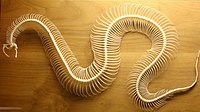
Photo from wikipedia
In the milling process, large tool diameter can get higher rigid and machining efficiency. To improve machining efficiency for 2 1/2-axis part, an image skeleton-based method is proposed in this… Click to show full abstract
In the milling process, large tool diameter can get higher rigid and machining efficiency. To improve machining efficiency for 2 1/2-axis part, an image skeleton-based method is proposed in this paper. First, a rasterization-based method for converting the part section graphics into an image for image analysis with high accuracy is developed. Second, the Euclidean distance field is calculated for the image to get the initial skeleton; then to get the accurate skeleton of the image, a partial differential equation-based method is employed to refine the initial skeleton. After that, an objective function based on the residual area of the material is established, which is solved by the genetic algorithm to obtain the optimal tool combination for a given number of tools. Finally, the developed approach is validated in the milling of a port part for tool selection. Results show that the selected toolset can remove most of the material effectively. Furthermore, analysis results show that the increase of tool types will increase the available cutting area ratio, but it will decrease the growth.
Journal Title: IEEE Access
Year Published: 2018
Link to full text (if available)
Share on Social Media: Sign Up to like & get
recommendations!